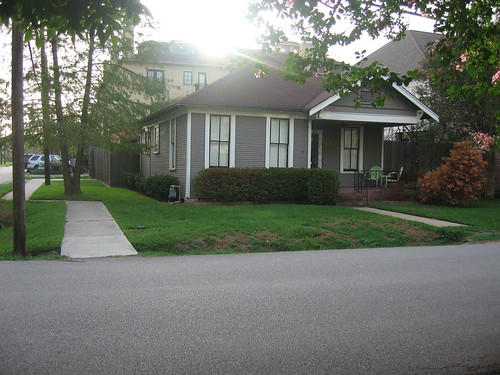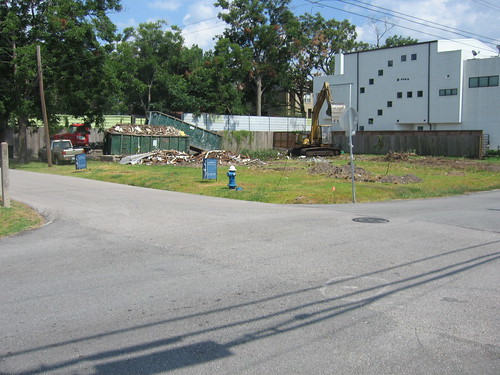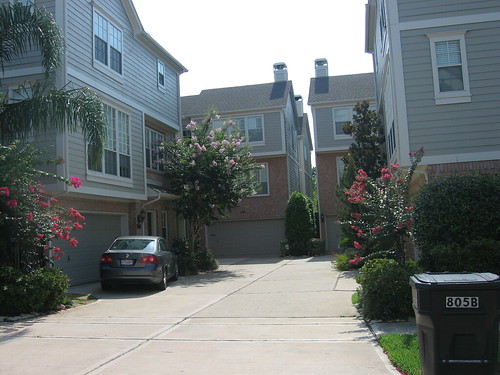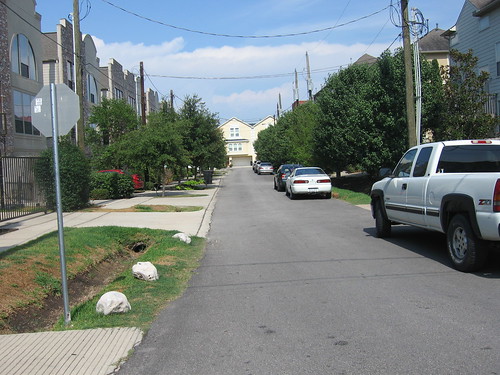Welcome to Houston
Hello from Texas!
A little over a year into property ownership in this town in which I have been resident for two years has been an education in “development without borders.” As many are no doubt aware, Houston, the fourth largest city in the country (a title once held by St. Louis), has no zoning laws. In addition, the building requirements are also quite minimal. Oh and historic preservation laws? Hardly. It makes for largely unregulated market-based development, and it’s interesting to see the results.
My current home is “Inside the Loop,” as we say here, which means it is inside the innermost highway ring of the city in which downtown is at the center. As urban as the location may be, it is a far cry from the layout I grew up with in Dogtown. My neighborhood is a redeveloped community that started turning over in the late 90’s, after Houston removed its minimum lot size restriction that had resulted in the building of tiny bungalows on huge lots for decades prior. It was a great plan for creating the urban density the city lacks, but it left the planning of that re-creation largely up to the developers who now buy the properties, tear them down, and squeeze massive townhouses into the space like mini cul-de-sacs.
Now that my neighborhood has almost completely turned over, it is easy to see where a little guidance from the local planning commission might have prevented a few of the annoyances we currently face over things like parking, sidewalks, and utilities. Alas, the “damage” has been done, and the residents are left to make it work somehow. This is good, in a way. It promotes community activism and participation in what your neighborhood becomes. When people decide they no longer can tolerate this style of community, they will move to an area that more closely fulfills their needs. If enough people turn away from this area, developers can tear down the current stuff and start all over with a new “product.” Market-based planning at its finest. It’s not very “green” but there are no rules against it, so it will happen.
It’s too early to predict how all of this will play out, so for now, I give you my neighborhood – and a couple of others later on – as they currently stand, along with the issues that come with them.
A well-kept version of the bungalows that used to dominate this neighborhood:

This is what is left of two nearby bungalows by 4 in the afternoon, after receiving demo permits that morning:

A typical townhouse cul de sac development. The prevailing design of the three story townhouse consists of two front entrances: one for the household cars and a much smaller one for the people. In some designs, the “front entrance” is on the side of the house. It is not very inviting for guests. Street parking is awkward as well, as can be seen in the following picture.

Another typical set up across from the cul de sacs – driveways on one side, narrow parking on the other. When this area started to redevelop, the city did not seem to pay any attention to the narrow streets, the awkward utilities, or the drainage options. As a result, the developers are able to build all the way up to the narrow right of way, and the residents play chicken with each other down the streets. The loser ends up in the drainage ditch or backing into the closest available driveway. There is talk of making the neighborhood streets one way and moving to permit parking. This will be an interesting issue to watch.

It’s been an interesting adjustment to change my expectations of what I think neighborhoods should have and what is provided. I’ll try to tackle a few of the areas of my neighborhood I would have liked to see done differently, plus show off a few of the other trends in other neighborhoods and a little bit of real estate politics down here as I go along. Be patient though! I also have to get your natural gas delivered safely to keep my own lights on!
– Liz Rutherford
If the new buildings were, instead, 75 years old, would the infrastructure concerns be viewed as negatives or positives? We want denser cities – this is. We want narrower streets, to slow down traffic and to encourage people to have fewer vehicles – these are. We want walkability – there are obviously some sidewalks. And I know Houston is growing their light rail system – what’s the access to public transit like? The three negatives I see are the noted drainage issues, the loss of some apparently pretty-cool bungalows and the use of generic contemporary building materials and details (which is exactly what the old bungalows used). Unfortunately, to get denser usually means replacing the old with the new – pick your poison. And, BTW, did you end up in an old bungalow or a new 3-story residence? It’s that old “If you’re not a part of the solution, you’re a part of the problem” – the market builds and sells what buyers buy . . .
Living in the Houston suburbs in high school is what made me the urban dweller I am today. The car culture of that sprawl wears you down. Inside the loop might be better. I hope it is.
Not all of us want slower traffic or fewer vehicles. My utopian cityscape includes hovercars for everyone zipping around at 100mph. Until such time as this vision is achieved, I’ll just have to settle for rolling through stop signs and using my dyslexia to justify going 52 in a 25…
Well Corondelet Ninja, it’s a good thing we make laws by majority representation and not consensus. I hope you get some pretty nasty tickets really soon…
Houston may be one of the best examples of “socialized costs, privatized profits” and therefore remains high on the list of the fastest growing cities. How long can it go on? How long before higher oil prices destroy the advantages of sprawl?
– –
I lived there and witnessed the giddy days when higher oil prices meant great fortunes being long production properties and facilitating daisy chain trading to profit handsomely by converting old oil into new oil. I was often the only person walking on sidewalks in a suit as most lived in their cars… often heard drivers scream “hey loser”. A pedestrian was someone who walked from their parked car in the corporate garage to the a/c elevators.
– –
Be extra careful in cycling in Texas: http://www.wfaa.com/sharedcontent/dws/news/localnews/stories/081709dnmetbicyclefatal.ed2cbdb4.html
Best quote I’ve heard about Texas: “If I owned Hell and Texas, I’d rent out Texas and live in Hell.” Houston is also one of most polluted cities in in the US (think petroleum products, etc.). For some peculiar reason, it doesn’t make it to official gov lists. Some political shenanigans, I suppose.
My favorite Colorado quote about Texans was “If God had intended for Texans to ski, He would’ve made bullsh*t white”.